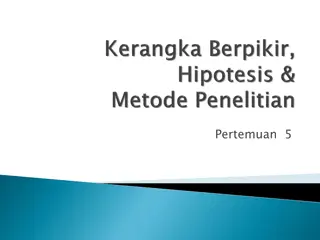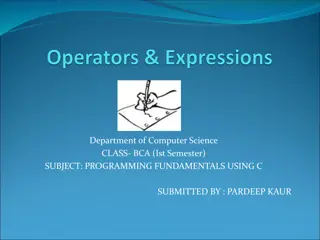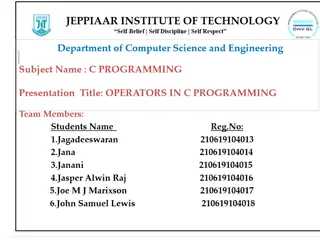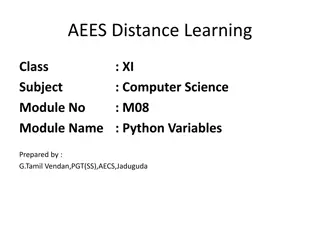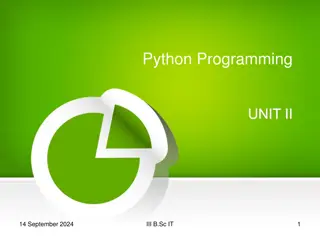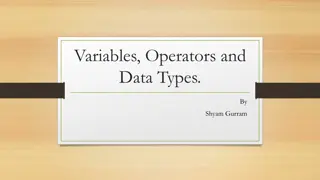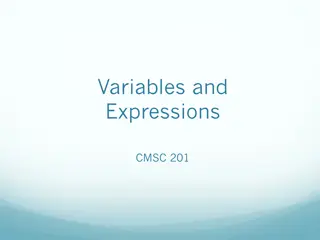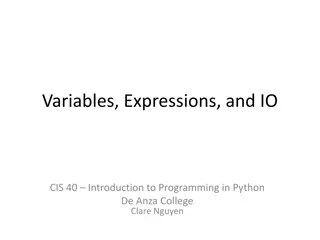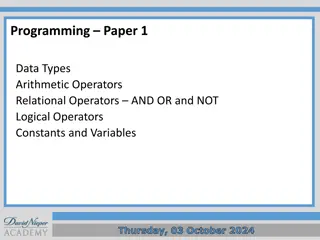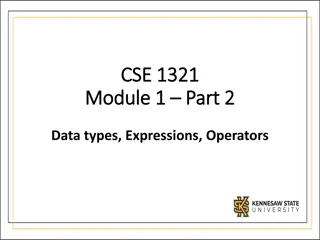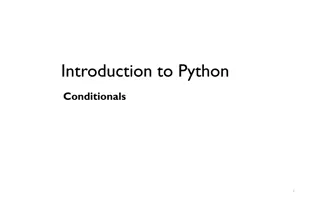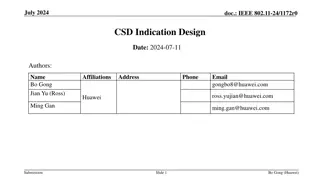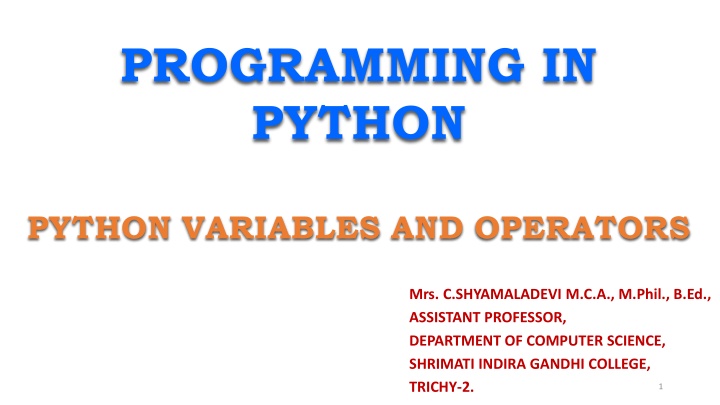
Python Programming: Variables, Operators, and Key Features
Dive into the world of Python programming with a focus on variables, operators, and key features. Explore the use of Graphical User Interface (GUI) and Integrated Development Environment (IDE) for creating Python programs, understand different data types, and learn about the history and versatility of Python as a general-purpose programming language supporting both Procedural and Object-Oriented approaches.
Download Presentation

Please find below an Image/Link to download the presentation.
The content on the website is provided AS IS for your information and personal use only. It may not be sold, licensed, or shared on other websites without obtaining consent from the author. If you encounter any issues during the download, it is possible that the publisher has removed the file from their server.
You are allowed to download the files provided on this website for personal or commercial use, subject to the condition that they are used lawfully. All files are the property of their respective owners.
The content on the website is provided AS IS for your information and personal use only. It may not be sold, licensed, or shared on other websites without obtaining consent from the author.
E N D
Presentation Transcript
PROGRAMMING IN PYTHON PYTHONVARIABLESANDOPERATORS Mrs. C.SHYAMALADEVI M.C.A., M.Phil., B.Ed., ASSISTANT PROFESSOR, DEPARTMENT OF COMPUTER SCIENCE, SHRIMATI INDIRA GANDHI COLLEGE, TRICHY-2. 1
Appreciate the use of Graphical User Interface (GUI) and Integrated Development Environment (IDE) for creating Python programs. Work in Interactive & Script mode for programming. Create and assign values to variables. Understand the concept and usage of different data types in Python. Appreciate the importance and usage of different types of operators (Arithmetic, Relational and Logical) Creating Python expression (s) and statement (s). 2
Python is a general purpose programming language Created by Guido Van Rossum from CWI (Centrum Wiskunde & Informatica) which is a National Research Mathematics and Computer Science in Netherlands. Institute for 3
The language was released in I991. Python got its name from a BBC comedy series from seventies- Monty Python s Flying Circus . Python supports both Procedural and Object Oriented programming approaches. 4
Key features of Key features of Python Python 5
It is a general purpose programming language which can be used for both scientific and non- scientific programming It is a platform independent programming language. The programs written in Python are easily readable and understandable. 6
Programming Programming in Python in Python 7
In Python, programs can be written in two ways namely Interactive mode Script mode The Interactive mode allows us to write codes in Python command prompt (>>>) In script mode programs can be written and stored as separate file with the extension .py and executed. Script mode is used to create and edit python source file. 8
Interactive mode Programming In interactive mode Python code can be directly typed and the interpreter displays the result(s) immediately. The interactive mode can also be used as a simple calculator. 9
Invoking Python IDLE 10
>>> 5/2 2.5 >>> 2/5 0.4 >>> 4%2 0 >>> 5%2 1 >>> 5//2 2 >>> 5+40 45 >>> 5**2 25 >>> 5+5*2 15 >>> a=3 >>> a+=4 >>> print(a) 7 13
Script mode Programming A script is a text file containing the Python statements. Python Scripts are reusable code. Once the script is created, it can be executed again and again without retyping. The Scripts are editable. 14
Input and Output Functions 15
A program needs to interact with the user to accomplish the desired task; this can be achieved using Input-Output functions. The input() function helps to enter data at run time by the user. The output function print() is used to display the result of the program on the screen after execution. 16
The print() function In Python, function is used to display result on the screen. the print() 17
Syntax print ( string to be displayed as output ) print (variable ) print ( String to be displayed as output , variable) print ( String1 , variable, String 2 , variable, String 3 ) 18
The print () evaluates the expression before printing it on the monitor. The print () displays an entire statement which is specified within print ( ). Comma ( , ) is used as a separator in print ( ) to print more than one item. 20
Example >>> x=5 >>> y=5 >>> z=x+y >>> print("The sum of ", x," and" , y," is ,z) The sum of 5 and 5 is 10 21
input( ) function In Python, input( ) function is used to accept data as input at run time. The syntax for input() function is, Variable = input ( prompt string ) 22
>>> name=input("enter your name:") enter your name: anupriya >>> print("i'm ",name) i m anupriya >>> city=input() trichy >>> print("im from:",city) im from: trichy 23
x,y=int (input("Enter Number 1:")), int(input("Enter Number 2:")) Enter Number 1 : 40 Enter Number 2: 30 >>> c=x+y >>> print(c) 70 24
Comments in Python 25
In Python, comments begin with hash symbol (#). The lines that begins with # are considered as comments and ignored by the Python interpreter. Comments may be Single line Multi-lines. The multiline comments should be enclosed within a set of # as given below. 26
Example # It is Single line Comment # It is multiline comment which contains more than one line # 27
Tokens 28
Python breaks each logical line into a sequence of elementary lexical components known as Tokens. 29
1) Identifiers 2) Keywords 3) Operators 4) Delimiters 5) Literals 30
Identifiers 31
An Identifier is a name used to identify a variable, function, class, module or object. 32
An identifier must start with an alphabet (A..Z or a..z) or underscore ( _ ). Identifiers may contain digits (0 .. 9) Python identifiers are case sensitive i.e. uppercase and lowercase letters are distinct. Identifiers must not be a python keyword. Python does not allow punctuation character such as %,$, @ etc., within identifiers. 33
Example of valid identifiers Sum, total_marks, regno, num1 Example of invalid identifiers 12Name, name$, total-mark, continue 34
Keywords 35
Keywords are special words used by Python interpreter to recognize the structure of program. As these words have specific meaning for interpreter, they cannot be used for any other purpose. 36
Operators 38
In computer programming languages operators are special symbols which represent computations, conditional matching etc. 39
The value of an operator used is called operands. Operators are categorized as Arithmetic, Relational, Logical, Assignment etc. Value and variables when used with operator are known as operands. 40
Arithmetic operators 41
An arithmetic operator is a mathematical takes two operands performs a calculation on them. They are used for simple arithmetic. operator that and 42
Most computer languages contain a set of such operators that can be used within equations to perform different types of sequential calculations. 43
>>> a=100 >>> b=10 >>> print ("The Sum = ",a+b) The Sum = 110 >>> print ("The Difference = ",a-b) The Difference = 90 >>> print ("The Product = ",a*b) The Product = 1000 >>> print ("The Quotient = ",a/b) The Quotient = 10.0 >>> print ("The Remainder = ",a%30) The Remainder = 10 >>> print ("The Exponent = ",a**2) The Exponent = 10000 >>> print ("The Floor Division =",a//30) The Floor Division = 3 44
Relational or Comparative operators 45
A Relational operator is also called as Comparative operator which checks the relationship between two operands. If the relation is true, it returns True; otherwise it returns False. 46
>>> a=10 >>> b=20 >>> a==b False >>> a<b True >>> a>b False >>> a<=b True >>> a>=b False >>> a!=b True 48
Logical operators 49
In python, Logical operators are used to perform logical operations on the given relational expressions. There are three logical operators they are and, or and not. 50

